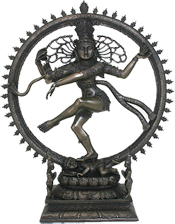Today kathak appears as a rhythm based dance that is performed according to Tabla based Nritya-bol. It's based on classical Hindustani music, has enormous spectrum and it is insperative, pious, subtle, and vigorous dance.
Kathak performance follows the tradition of opening the show with a prayer, lyrics, mythological stories endowed with praises of the deities and the additions like Amad, That, nikas, Tarana, Gazal that has been added to kathak in mughal period are also performed with same furvour.
During last 2-3 centuries many kathak gurus kept the dance traditions alive
while it was performed in the royal courts of kings and Nawabs, added some beautiful things in
it and introduced the concept of solo performance. In this period various various styles ok kathak evolved
which are known as Jaipur, Lucknow and Banaras gharana. We find many able kathak
exponents representing these gharanas all over India.
I represent Jaipur dance style particularly that Dr. Padmashree
Roshankumari has developed and popularized in dance sphere. Roshanji is daughter of late Fakir Mohammad and singer Johra Begum Ambalewali. She has been groomed under the tutelage of Guru K.S.More, Pandit Sunder Prasad and Pandit Hanuman Prasad. The specialties of her dance are forceful foot work of Tatkar, clear and elegant body movement, speedy chakris, use of complicated rhythm based compositions. Her skill in producing vigorous and devotional mood gracefully won audience's heart to such extent that none of them could forget her dance till date.
It's my aim to propagate and popularize Guru Roshankumari's dance style and with this intention I have started the work of this video and website.
From ancient period the art of dance has been carried forward through
Guru-shishya parampara. Dance is an art that cannot be learned by reading the script, observing others or following other's instructions. It needs a Guru who can transform the art into his disciple's mind and body. |

